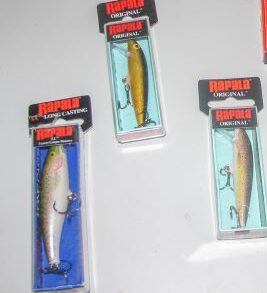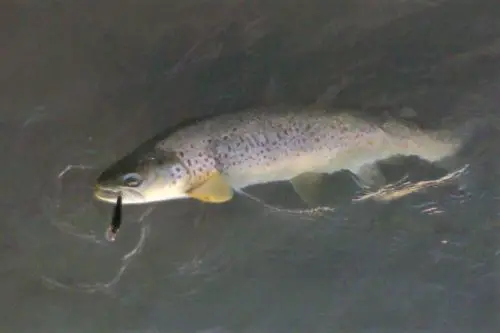Ever went into a fishing store, and looked at all the Rapala lures on display. Two of the most common models being the Original Floater and the Xrap. But, which lure is best and how do they compare to each other?
While this article is primarily going to be focused on trout fishing, I have also used both models to catch a wide variety of fish, in both freshwater and salt. Much of what I write, is also relevant to other species and scales up even to the larger size lures.
The Obvious Differences
There are some differences which are very obvious, the first is price. The Xrap is a few dollars more expensive.
The second most obvious difference is that the Xrap has dressed hooks while the Original Floater typically has naked hooks. There is some evidence that the extra movement from dressed hooks can trigger trout to strike.
The final obvious difference is that the finish of the Xrap is a lot more detailed with a textured body and holographic eyes being very apparent.
Construction
At a glance these two lures look quite similar, but they are constructed out of different materials. The Original Floater is constructed from Balsa wood, while the Xrap is made from ABS plastic.
Both materials are extremely durable. I have X-raps and Original floaters over a decade old and they still catch fish.
Hooks
Both lures use VMC nickel hooks. These hooks are perfectly fine for trout and most freshwater fishing. I never had a problem with them distorting or breaking on a fish and they are easily sharp enough. I have read many reports of them breaking, but it does make me wonder just how much drag pressure these anglers were using.
These hooks are primarily designed to be fished in the freshwater, so when using them to target hard fighting saltwater pelagic such as Tuna I do change them out for stronger hooks. These strong fighting fish do require a lot more drag to control.

The Main difference between Xraps and Original floater
I have gotten the boring stuff out of the way. The main difference is that the Xrap is a suspending lure, while the Original floater is a floating lure.
What does that mean? On the water you cast out the original floater, and it floats until you start to retrieve it then it dives under. If you stop reeling, the lure then floats towards the surface.
On the other hand, you cast out the Xrap, it to dives down on the retrieve, but on the pause, it suspends and holds its depth. It does not continue to sink, it does not float back to the surface.
“The Floater Floats and the Xrap suspends”
If you are just casting out, and retrieve in a straight line. There will be little difference between the two lures. But, if you are fishing around structure, or trying to hold it in the current the difference between the two is like night and day.
When is the Original floater better?
– I like to use a floater when fishing around, and over submerged trees. I can cast over the trees, let the lure dive down. Then just before reaching the branches, I pause and let the lure float to the surface. I then slowly work the lure across the branches, once out of the snag zone I wind quickly to get it down deep and continue my retrieve. It also works well across and around weed beds.
– When trolling. I much prefer the original floater when trolling. Because when I stop paddling, I know it will float to the surface, and not eventually sink to snag.
– When I use the wind and current, to ‘float’ the lure beneath stream side vegetation. I basically cast out, and let the lure float on the surface. I then close the bail. The wind and current would then cause the lure to pivot around where I am standing forcing it to swing in parallel to the shore and under branches I could not possibly cast.
– When ultimate finesse is required. There is just something about Balsa lures, they have a softer more neutral action which just seems more natural. When the fish are being very wary, I find the original floater is more likely to trigger a response.
When is the Rapala Xrap better?
– The main time I love to use the Xrap is when I want to pause and suspend my lure mid-retreive. Imagine if the trout are following. Sometimes pausing the lure, and having it suspend right in front of them is enough to trigger a strike. I have had following trout, stop, and swim around a suspended lure several times before grabbing it. In that amount of time it took the trout to decide, a floater would of been on the surface.
– When fishing downstream, it is possible to hold and suspend a x-rap mid current. This makes it possible to position the Rapala directly in the strike zone. With care, it is even possible to drift a suspended lure beneath over hanging vegetation.
– The X-rap is an easier lure to cast. All but the smallest size, comes with an integrated weight which assists in longer casts.
Summary
In my experience, both the Rapala Xrap and the original floater are excellent lures. They are among the most consistent lures I have tried to catch trout and other predatory fish.
The main point which separates these two lures, is not the visual differences, but the fact that one is a floating lure, and the other a suspending lure. I always have both versions with me when spinning on the river.
If you are interesting to hear how other jerkbaits compare, including the jointed-Rapalas. I suggest checking my guide here where I compare 9 of the most popular models.

